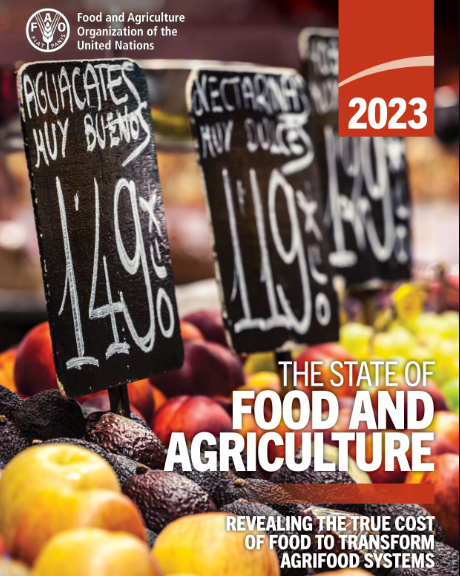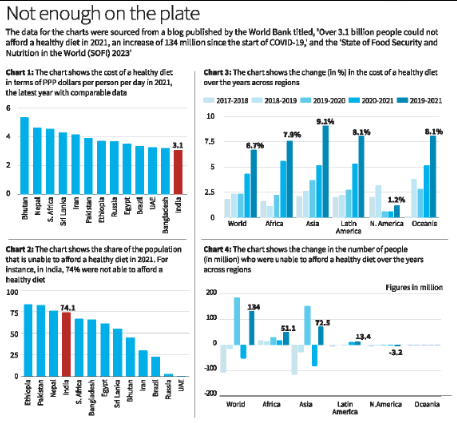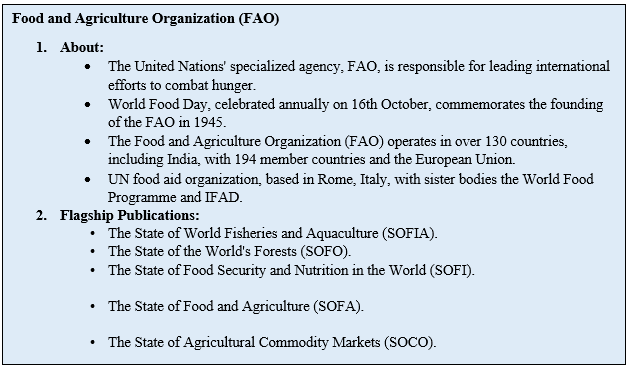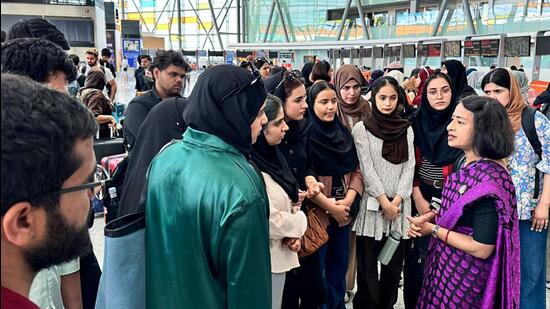- Courses
- GS Full Course 1 Year
- GS Full Course 2 Year
- GS Full Course 3 Year
- GS Full Course Till Selection
- Answer Alpha: Mains 2025 Mentorship
- MEP (Mains Enrichment Programme) Data, Facts
- Essay Target – 150+ Marks
- Online Program
- GS Recorded Course
- Polity
- Geography
- Economy
- Ancient, Medieval and Art & Culture AMAC
- Modern India, Post Independence & World History
- Environment
- Governance
- Science & Technology
- International Relations and Internal Security
- Disaster Management
- Ethics
- NCERT Current Affairs
- Indian Society and Social Issue
- NCERT- Science and Technology
- NCERT - Geography
- NCERT - Ancient History
- NCERT- World History
- NCERT Modern History
- CSAT
- 5 LAYERED ARJUNA Mentorship
- Public Administration Optional
- ABOUT US
- OUR TOPPERS
- TEST SERIES
- FREE STUDY MATERIAL
- VIDEOS
- CONTACT US
The State of Food and Agriculture 2023
The State of Food and Agriculture 2023
10-11-2023

Why in News?
Recently, a FAO's report, 'The State of Food and Agriculture 2023', highlights the significant negative effects of unhealthy diets and ultra-processed foods on health and the environment.
Key Findings
- Hidden Costs of Unhealthy Diets:
- Unhealthy diets, characterized by ultra-processed foods, fats, and sugars, often result in significant hidden costs.
- The annual costs of health-related issues like obesity and non-communicable diseases exceed USD 7 trillion, highlighting the economic burden on the economy.
- Global Impact and Economic Burden:
- The majority of hidden costs were generated in upper-middle-income and high-income countries (36% and 22% respectively), with lower-middle-income countries at 22% and low-income countries at 3%.
- Unhealthy
- diets lead to hidden costs of at least USD 10 trillion annually, accounting for nearly 10% of the global GDP.
- The analysis covers 154 countries and highlights the significant impact of these dietary patterns.
- Impact on India:
- India's agri-food system costs, totaling around USD 1.1 trillion, are the third-largest globally after China and the United States.
- In India, the largest hidden costs are the burden of disease, social costs of poverty, and environmental costs from nitrogen emissions.
- Rapid Spread of Processed Foods:
- The consumption of highly processed foods is increasing globally, particularly in peri-urban and rural areas.
- Urbanization, lifestyle changes, and shifts in employment profiles are driving this trend.
- Longer commuting times in certain areas have led to an increase in the consumption of processed foods.
- Urban vs. Rural Consumption Patterns:
- The report challenges the conventional belief that consumption patterns significantly differ between urban and rural areas.
- The study reveals that processed foods are widely and uniformly distributed across the rural-urban continuum.
- Processed foods significantly contribute to overall consumption in both high and low-food-budget countries, with urbanization not being the sole driving force.
- Global Food Insecurity:
- Global food insecurity, particularly moderate or severe, remained largely unchanged for the second consecutive year.
- In 2022, approximately 29.6% of the global population, or 2.4 billion people, experienced moderate or severe food insecurity.
- Around 11.3% of the global population, or approximately 900 million individuals, are currently experiencing severe food insecurity.
- India ranks third in South Asian countries with the highest prevalence of undernourishment, after Afghanistan and Pakistan, according to an analysis.
- Low-income countries face significant hidden costs of agri-food systems, accounting for over a quarter of their GDP, compared to less than 12% in middle-income and 8% in high-income countries.
- Future Projections and Undernourishment:
- The report predicts that by 2030, approximately 600 million people will be experiencing chronic undernourishment.

How can the Burden of Ultra-processed Foods be Reduced?
- Transforming current agri-food systems can reduce the burden of ultra-processed foods by promoting sustainability, health, and inclusivity.
- Promoting the consumption of diverse, nutritious, and less processed foods like fruits, vegetables, legumes, nuts, seeds, and whole grains.
- The regulation of ultra-processed foods' marketing, labeling, and taxation, along with the provision of subsidies and incentives for healthier options, is being implemented.
- The focus is on enhancing the accessibility and affordability of healthy foods, particularly for low-income and vulnerable populations, through social protection, food assistance, and public procurement.
- The initiative aims to educate and empower consumers to make informed, healthy food choices through nutrition education, behavior change communication, and digital technologies.
- The focus is on improving the efficiency and circularity of agrifood systems by reducing food losses, waste, enhancing resource use, and embracing cleaner, renewable energy sources.
- The focus is on improving governance and coordination of agrifood systems by engaging stakeholders, promoting innovation, conducting research, and monitoring the effects and outcomes.
Government Initiatives to Promote Healthy Lifestyle
- The National Food Security Act (NFSA), 2013.
- PM-POSHAN Scheme.
- Fit India Movement.
- Eat Right Movement.
- Eat Right Station Certification.
- Eat Right Mela.




